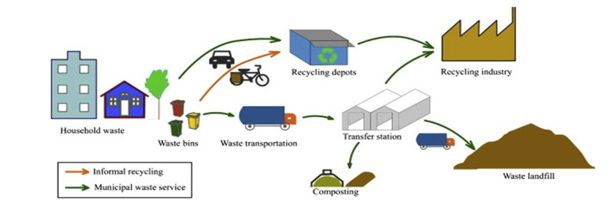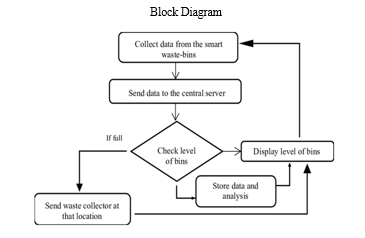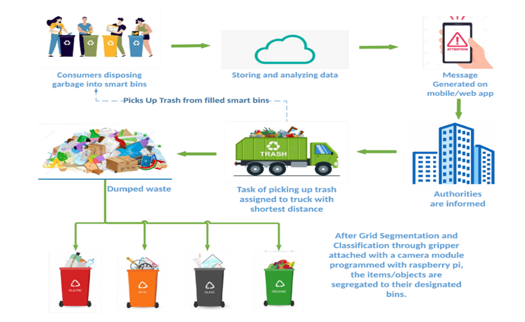Ijraset Journal For Research in Applied Science and Engineering Technology
- Home / Ijraset
- On This Page
- Abstract
- Introduction
- Conclusion
- References
- Copyright
Blockchain for Waste Management in Smart Cities
Authors: Vaibhav Gaikwad, Rajnandini Tikkal, Shantilal Kopnar, Mahesh Nikam, Prof. Suryavanshi A.P.
DOI Link: https://doi.org/10.22214/ijraset.2024.61599
Certificate: View Certificate
Abstract
Waste management has long been a concern for societies, with its historical roots tracing back to the prehistoric era. Despite its prevalence, defining what constitutes waste remains a challenge, given its subjective nature. This paper delves into the concept of waste, exploring its historical contexts, sources, and classification. Utilizing a desktop study approach, it synthesizes information from various scholarly sources to shed light on this critical aspect of environmental management. The findings underscore the importance of clear definitions and effective management strategies to mitigate the adverse impacts of waste on public health and the environment.
Introduction
I. INTRODUCTION
The production of waste has been an inherent aspect of human activities throughout history, with its significance escalating in modern times. As populations burgeon and urbanization accelerate, the volume and diversity of waste generated have reached unprecedented levels. However, amidst the plethora of waste materials, delineating what qualifies as waste remains elusive. This paper aims to elucidate the concept of waste, tracing its historical evolution and examining its diverse sources and classification schemes. By synthesizing insights from existing literature, it endeavours to offer clarity on this multifaceted issue and underscore the imperative of robust waste management practices.
II. CONCEPT OF WASTE
Waste, often perceived as the by-product of human endeavours, defies a singular definition due to its subjective nature. While one individual may deem a substance as waste, another might view it as a valuable resource. This inherent subjectivity underscores the need for precise definitions to underpin regulatory frameworks governing waste management. Historically, waste management practices have evolved from rudimentary disposal methods to sophisticated strategies aimed at safeguarding public health and environmental integrity.

III. WORKING
A. Key Components
- Blockchain Network: Utilizes a distributed ledger technology where data is stored across multiple nodes, ensuring transparency and security.
- User Interface: Provides a user-friendly interface for stakeholders to access and interact with the system.
B. Workflow
- Data Collection: Smart bins continuously monitor waste levels and other relevant data using sensors. This data is transmitted to the blockchain network.
- Transaction Recording: Each data transmission triggers a transaction on the blockchain, recording information such as bin ID, waste level, timestamp, and location. This transaction is cryptographically secured and immutable.
- Smart Contracts: Utilized for automating certain actions based on predefined conditions. For example, when a bin reaches a certain capacity threshold, a smart contract can trigger a notification to waste management authorities for timely collection.
- Data Analysis and Reporting: Waste management authorities can analyze the data stored on the blockchain to gain insights into waste generation patterns, optimize collection routes, and make informed decisions.
- Incentive Mechanisms: Blockchain can facilitate incentive programs by rewarding users or communities for proper waste disposal practices, such as recycling or reducing waste generation.
???????C. Benefits
- Transparency: All transactions and data are recorded on the blockchain, providing transparency and accountability in waste management operations.
- Traceability: Stakeholders can track the journey of waste from generation to disposal, ensuring compliance with regulations and environmental standards.
- Efficiency: Real-time monitoring and automation streamline waste collection processes, leading to cost savings and improved resource allocation.
- Environmental Impact: By incentivizing responsible waste management practices, the project contributes to environmental sustainability and pollution reduction.
???????D. Challenges and Considerations
- Scalability: Ensuring the scalability of the blockchain network to handle a large volume of transactions and data from numerous smart bins.
- Interoperability: Integrating with existing waste management systems and standards to facilitate seamless data exchange and interoperability.
- Data Privacy and Security: Implementing robust security measures to protect sensitive data and prevent unauthorized access or tampering.
- Regulatory Compliance: Adhering to relevant regulations and standards governing waste management and blockchain technology.
IV. METHODOLOGY
A. Project Planning and Requirements Gathering
- Define Project Objectives: Clearly outline the goals and objectives of the smart waste management project, such as improving efficiency, promoting sustainability, and enhancing transparency.
- Identify Stakeholders: Determine the key stakeholders involved, including waste management authorities, municipal bodies, and end-users.
- Gather Requirements: Conduct workshops and interviews to gather requirements from stakeholders regarding functionalities, data collection parameters, user interface preferences, and regulatory compliance.
???????B. Technology Selection and Architecture Design
- Choose blockchain Platform: Select a suitable blockchain platform based on factors like scalability, security, consensus mechanism, and developer support. Options include Ethereum, Hyperledger Fabric, or custom-built solutions.
- Design System Architecture: Create a high-level architecture design outlining the components, interactions, and data flows within the system, including smart bins, blockchain network, smart contracts, and user interface.
- Define Data Schema: Design the data schema for storing waste management-related information on the blockchain, considering factors like data structure, encryption, and privacy requirements.
???????C. Prototype Development and Testing
- Develop Smart Contracts: Write and deploy smart contracts to the blockchain network to handle functionalities such as data recording, event Triggering, and incentive mechanisms.
- Implement user Interface: Design and develop a user-friendly interface for stakeholders to interact with the system, including features like real-time monitoring, data visualization, and reporting.
- Conduct Testing: Perform unit testing, integration testing, and user acceptance testing to validate the functionality, reliability, and usability of the system components.
???????D. Deployment and Integration
- Deploy blockchain Network: Set up and configure the blockchain network infrastructure, including nodes, consensus mechanism, and security protocols, either on-premises or using cloud-based solutions.
- Integrate with Existing Systems: Integrate the smart waste management system with existing waste management systems, databases, and APIs to facilitate seamless data exchange and interoperability.
???????E. Pilot Testing and Iterative Improvement
- Conduct pilot Testing: Deploy the smart waste management system in a controlled environment or pilot area to gather feedback, identify issues, and assess the system's performance in real-world scenarios.
- Collect Feedback: Solicit feedback from stakeholders, including waste management authorities, users, and technical experts, to identify areas for improvement and optimization.
- Iterate and Enhance: Incorporate feedback and lessons learned from pilot testing to iterate on the system design, functionality, and user experience, implementing enhancements and optimizations as needed.
???????F. Deployment and Scaling
- Roll out full Deployment: Deploy the smart waste management system across the target locations or communities, ensuring proper training, documentation, and support for stakeholders.
- Monitor and Maintain: Implement monitoring tools and processes to monitor the performance, security, and scalability of the system, proactively addressing issues and optimizing resource utilization.
- Scale up: Scale the system to accommodate increasing data volume, user base, and geographic coverage, leveraging scalability features and infrastructure scaling techniques as needed.
???????G. Continuous Improvement and Sustainability
- Establish Governance Framework: Define governance mechanisms and policies for managing and evolving the smart waste management system over time, including version control, change management, and compliance.
- Foster Ecosystem Growth: Collaborate with ecosystem partners, such as technology vendors, waste management authorities, and community organizations, to promote adoption, innovation, and sustainability of the system.
- Monitor Impact: Monitor the impact of the smart waste management system on key metrics like waste diversion rates, operational efficiency, and environmental outcomes, periodically evaluating its effectiveness and identifying areas for improvement.
V. ARCHITECTURE
A. Components
- Smart Bins: Equipped with sensors for waste level detection, temperature, humidity, and location tracking.
- Blockchain Network: Provides a decentralized and immutable ledger for recording waste management transactions.
- Smart Contracts: Self-executing contracts deployed on the blockchain for automating processes and enforcing rules.
- User Interface: Web or mobile interface for stakeholders to interact with the system, monitor data, and manage waste-related activities.
???????B. Architecture Layer
- Data Collection Layer: Smart bins equipped with sensors continuously monitor waste levels, temperature, humidity, and other parameters.
- Blockchain Layer: Consists of multiple nodes running blockchain software (e.g., Ethereum, Hyperledger Fabric). Transactions related to waste management activities are recorded as blocks on the blockchain. Each transaction contains metadata such as bin ID, waste level, timestamp, and location. Smart contracts govern various aspects of the system, such as triggering alerts when bins reach capacity thresholds or facilitating incentive programs.
- Data Processing and Analysis Layer: Data analytics tools analyze the data stored on the blockchain to derive insights into waste generation patterns, optimize collection routes, and make informed decisions. Machine learning algorithms may be employed for predictive analytics and anomaly detection.
- User Interface Layer: Provides a user-friendly interface accessible via web browsers or mobile apps. Allows stakeholders, including waste management authorities, municipal bodies, and end-users, to: Monitor real-time data from smart bins (e.g., fill levels, temperature). Receive alerts and notifications for timely waste collection. View historical data, analytics reports, and performance metrics. Participate in incentive programs and track rewards.
???????C. Integration Points
- Blockchain Integration: Integration of blockchain network with Collect data for secure data transmission. Development and deployment of smart contracts to enforce business logic and automate processes.
- User Interface Integration: Integration of user interface with blockchain nodes to fetch real-time data and display it to stakeholders. Implementation of authentication and authorization mechanisms to ensure secure access to the system.
???????D. Security Considerations
- Data Encryption: Encrypt data transmitted between smart bins, and blockchain nodes to prevent unauthorized access.
- Access Control: Implement role-based access control (RBAC) to restrict access to sensitive information and system functionalities.
- Blockchain Security: Follow best practices for securing blockchain networks, such as using strong cryptographic algorithms, multi-factor authentication, and regular security audits.
- Secure Communication: Employ secure communication protocols (e.g., HTTPS, TLS) for data transmission between components.
- Immutable Audit Trail: Leverage blockchain's immutable ledger to maintain an audit trail of all transactions, ensuring transparency and traceability.
???????E. Scalability and Performance:
- Design the architecture to be horizontally scalable to accommodate a growing number of smart bins, and users.
- Employ techniques such as sharding (for blockchain networks) and load balancing (for user interfaces) to distribute workload and improve performance.
- Monitor system performance regularly and optimize resource utilization to ensure smooth operation under varying loads.

VI. PROPOSED SYSTEM
A. Objective
Improve waste management practices through the implementation of blockchain technology, and smart contracts.
The proposed system aims to enhance waste management practices by utilizing blockchain technology and smart contracts. Blockchain technology will be leveraged to create a secure and transparent ledger for recording key information related to waste management, including waste types, quantities, collection schedules, and disposal locations. This blockchain ledger will enable stakeholders such as waste management companies, municipalities, and regulators to access accurate and immutable data, thereby improving accountability and traceability in waste management processes. Smart contracts will automate various aspects of waste management, such as scheduling collections, managing payments, and enforcing compliance with regulations. By implementing blockchain and smart contracts, the objective is to streamline waste management operations, reduce inefficiencies, enhance transparency, and promote sustainable practices within smart city environments.

B. Key Components
- Blockchain Network: Provides a decentralized and immutable ledger for recording waste management transactions.
- Smart Contracts: Self-executing contracts deployed on the blockchain for automating processes and enforcing rules.
- User Interface: Web or mobile interface for stakeholders to interact with the system, monitor data, and manage waste-related activities.
C. Functionality
- Real-time Monitoring: Stakeholders can monitor the fill levels of smart bins, temperature, humidity, and other relevant parameters in real-time through the user interface.
- Automated Alerts: Smart contracts trigger alerts and notifications when bins reach capacity thresholds or when maintenance is required, ensuring timely waste collection and maintenance.
- Data Analytics: Analyze data stored on the blockchain to derive insights into waste generation patterns, optimize collection routes, and make informed decisions.
- Incentive Programs: Implement incentive programs to reward users or communities for proper waste disposal practices, such as recycling or reducing waste generation.
VII. CLASSIFICATION AND TYPES OF WASTE
Waste manifests in myriad forms, necessitating diverse classification schemes based on physical states, sources, and environmental impacts. Commonly classified into solid, liquid, and gaseous categories, waste materials encompass a broad spectrum ranging from household refuse to industrial by-products. Solid waste, in particular, encompasses a heterogeneous array of materials, including municipal, construction, industrial, agricultural, and commercial wastes. Understanding the distinct characteristics and sources of each waste stream is pivotal for devising tailored management strategies to mitigate their adverse effects.
This work is licensed under a Creative Commons Attribution 4.0 License. For more information, see https://creativecommons.org/licenses/by/4.0/
This article has been accepted for publication in a future issue of this journal, but has not been fully edited. Content may change prior to final publication. Citation information: DOI10.1109/ACCESS.2021.3113380, IEEE Access
A. Municipal Solid Waste (MSW)
Among the various waste streams, municipal solid waste (MSW) emerges as a focal point due to its ubiquitous nature and direct interface with communities. Comprising household and commercial discards, MSW poses significant challenges in terms of collection, treatment, and disposal. Its diverse composition, spanning organic matter, plastics, metals, and paper, underscores the complexities inherent in managing urban waste streams. Effective MSW management necessitates comprehensive strategies encompassing waste reduction, recycling, and environmentally sound disposal practices.
B. Construction Waste
The construction industry constitutes a major contributor to solid waste generation, characterized by diverse materials such as concrete, wood, metals, and plastics. Rapid urbanization and infrastructure development amplify the volume of construction waste, necessitating concerted efforts to minimize environmental repercussions. Sustainable construction practices, including waste reduction, reuse, and recycling, are imperative for mitigating the ecological footprint of this burgeoning waste stream.
C. Industrial Waste:
Industries, spanning manufacturing, mining, and processing sectors, generate a plethora of waste materials during production processes. Ranging from toxic by-products to inert residues, industrial waste poses unique challenges due to its varied composition and potential environmental hazards. Sustainable industrial practices, coupled with stringent regulatory oversight, are essential for minimizing the ecological footprint of industrial activities and fostering resource conservation.
D. Retail Waste:
Retail activities contribute significantly to solid waste generation, encompassing diverse materials ranging from packaging to organic waste. A report by the Department for Environment, Food & Rural Affairs (DEFRA, 2011) highlights the extensive array of non-metallic waste generated by the retail sector, reflecting the nature of goods sold. For instance, grocery stores produce substantial amounts of waste, including fruits, baked products, seafood, and packaging materials, as revealed by a survey conducted in Quebec, Canada (Norrie et al., 1997). In the UK alone, the retail sector generated approximately 1.4 million tons of packaging and food waste in 2008, underscoring the magnitude of waste generation within this sector (WRAP, 2011). The disposal of retail waste poses both environmental and economic challenges, with supermarkets, for instance, incurring substantial costs for waste disposal (Norrie et al., 1997; Ochoa et al., 2010). Implementing recycling and reuse initiatives can serve as effective waste management strategies, offering opportunities for cost recovery and environmental sustainability (Ochoa et al., 2010).
VIII. WASTE MANAGEMENT
Waste management has evolved into a critical component of environmental stewardship, necessitated by escalating waste production resulting from human activities. The proliferation of goods to meet burgeoning demand, driven by population growth and increased purchasing power, has exacerbated waste generation, burdening the environment (Vergara & Thabang’s, 2012; Marchetti et al., 2007). To mitigate the adverse impacts of waste on public health and environmental integrity, comprehensive waste management strategies are imperative. Defined by Demibras (2011) as a process encompassing the collection, transportation, processing, and disposal of waste, waste management demands interdisciplinary expertise spanning legal, financial, and administrative domains. Sustainable waste management practices prioritize waste reduction, reuse, recycling, composting, and energy recovery over landfilling, recognizing the environmental and economic benefits of resource conservation.
Despite technological advancements, landfilling remains the ultimate destination for a significant portion of waste, underscoring the need for ongoing innovation and improvement in waste management practices (Strange, 2002).
IX. EXISTING WASTE MANAGEMENT SYSTEMS
Traditional waste management systems aim to collect, transport, and dispose of waste efficiently while adhering to environmental regulations.
A. Key Components
- Bins and Containers: Standard waste bins and containers placed in residential, commercial, and industrial areas for waste collection.
- Collection Vehicles: Trucks and vehicles equipped with compactors for collecting waste from bins and transporting it to treatment or disposal facilities.
- Waste Processing Facilities: Facilities for sorting, recycling, composting, and disposing of waste in an environmentally friendly manner.
- Regulatory Compliance: Adherence to local, regional, and national regulations governing waste management practices, including waste segregation, recycling targets, and landfill diversion rates.
B. Functionality
- Scheduled Collection: Waste collection schedules based on the type of waste, location, and volume, ensuring timely removal of waste from designated areas.
- Waste Sorting and Processing: Sorting and processing of waste at facilities to recover recyclable materials, compost organic waste, and dispose of non-recyclable waste responsibly.
- Regulatory Reporting: Compliance with regulatory reporting requirements, including waste audits, recycling rates, and landfill diversion metrics, to ensure adherence to environmental regulations.
- Community Engagement: Public awareness campaigns, education programs, and outreach initiatives to promote waste reduction, recycling, and sustainable waste management practices among residents and businesses.
C. Comparison:
- Technology Adoption: The proposed system integrates blockchain technology and IoT devices for real-time monitoring and automation, offering advanced features not available in traditional waste management systems.
- Transparency and Traceability: Blockchain-based systems provide transparency and traceability in waste management transactions, enabling stakeholders to track the journey of waste from generation to disposal, which is often lacking in existing systems.
- Efficiency and Optimization: Smart waste management systems leverage data analytics and automation to optimize waste collection routes, reduce operational costs, and improve resource allocation, offering higher efficiency compared to traditional systems.
- Incentive Mechanisms: The proposed system introduces incentive programs to reward responsible waste disposal practices, fostering community participation and engagement, which may not be prevalent in existing waste management systems.
X. FEATURE SCOPE
Implementing blockchain technology and IoT devices for waste management in smart cities involves deploying smart waste bins equipped with IoT sensors to monitor fill levels and location, facilitating real-time data collection.
The data collected, including waste types, quantities, and disposal details, is securely recorded on a blockchain ledger, ensuring transparency and traceability throughout the waste management process. Smart contracts automate tasks like scheduling waste collection and incentivizing citizen participation in recycling programs. This decentralized approach fosters direct stakeholder interaction, improves operational efficiency through data analytics, and promotes sustainability by optimizing resource utilization and reducing environmental impact. Integration with existing smart city infrastructure and rigorous security measures ensure scalability, privacy, and compliance with regulatory standards, making this solution integral to building cleaner, more efficient urban environments.
Conclusion
The concept of waste, though subjective, necessitates clear definitions to guide policy formulation and waste management practices. As waste generation escalates globally, effective waste management emerges as a cornerstone of environmental sustainability, paralleling essential public amenities. Planning for future waste generation trends is essential to prevent indiscriminate disposal and mitigate associated health and environmental risks. Embracing sustainable waste management practices, including waste reduction and recycling initiatives, is imperative to safeguard public health and environmental well-being.
References
[1] Bank for International Settlements. (2018). V. Cryptocurrencies: looking beyond the hype. Retrieved from Basel: [2] Beede, D. N., & Bloom, D. E. (1995). The economics of municipal solid waste. The World Bank Research Observer, 10(2), 113-150. [3] Berg, H., & Sebestyén, J. (2020). Phillip Bendix (Wuppertal Institute), Kévin Le Blevennec (VITO), Karl Vrancken (VITO). [4] Bertanza, G., Ziliani, E., & Menoni, L. (2018). Techno-economic performance indicators of municipal solid waste collection strategies. Waste Management, 74, 86-97. [5] Carson, B., Romanelli, G., Walsh, P., & Zhumaev, A. (2018). Blockchain beyond the hype: What is the strategic business value. McKinsey & Company, 1. [6] Blockchain technology in waste management: Present scenario and future outlook\" by Gupta, S., Mishra, S., & Jain, R. (2020). [7] A blockchain-based approach towards securing smart waste management systems\" by Zhiyuan Tan, Xinyi Huang, Shangguang Wang, and Wenjie Yang (2019). [8] Blockchain and the Internet of Things in the industrial sector: A systematic literature review\" by Khan, Z. H., Anjum, A., Soomro, T. R., & Guizani, M. (2019). [9] Blockchain in Waste Management - Global Market Outlook (2017-2026)\" by Stratistics Market Research Consulting (2019). [10] Beede, D. N., & Bloom, D. E. (1995). The economics of municipal solid waste. The World Bank Research Observer, 10(2), 113-150. [11] Berg, H., & Sebestyén, J. (2020). Phillip Bendix (Wuppertal Institute), Kévin Le Blevennec (VITO), Karl Vrancken (VITO). [12] Bertanza, G., Ziliani, E., & Menoni, L. (2018). Techno-economic performance indicators of municipal solid waste collection strategies. Waste Management, 74, 86-97. [13] Carson, B., Romanelli, G., Walsh, P., & Zhumaev, A. (2018). Blockchain beyond the hype: What is the strategic business value. McKinsey & Company, 1. [14] Bank for International Settlements. (2018). V. Cryptocurrencies: looking beyond the hype. Retrieved from Basel. [15] S. Nakamoto and A. Bitcoin, “A peer-to-peer electronic cash system,” Bitcoin.–URL: https://bitcoin. org/bitcoin. pdf, vol. 4, p. 2, 2008. [16] J. Xie, H. Tang, T. Huang, F. R. Yu, R. Xie, J. Liu, and Y. Liu, “A surveyof blockchain technology applied to smart cities: Research issues and challenges,” IEEE Communications Surveys & Tutorials, vol. 21, no. 3, pp. 2794–2830, 2019. [17] A. Rejeb, K. Rejeb, S. J. Simske, and J. G. Keogh, “Blockchain technology in the smart city: A bibliometric review,” Quality & Quantity,vol. 56, no. 5, pp. 2875–2906, 2022. [18] F. Ullah and F. Al-Turjman, “A conceptual framework for blockchain smart contract adoption to manage real estate deals in smart cities,” Neural Computing and Applications, pp. 1–22, 2021. [19] N. F. M. Shari and A. Malip, “State-of-the-art solutions of blockchain technology for data dissemination in smart cities: A comprehensivereview,” Computer Communications, 2022. [20] A. Sharma, E. Podoplelova, G. Shapovalov, A. Tselykh, and A. Tselykh,“Sustainable smart cities: convergence of artificial intelligence and blockchain,” Sustainability, vol. 13, no. 23, p. 13076, 2021. [21] R. Godahewa, C. Deng, A. Prouzeau, and C. Bergmeir, “A generative deep learning framework across time series to optimize the energy consumption of air conditioning systems,” IEEE Access, vol. 10, pp. 6842– 6855, 2022.
Copyright
Copyright © 2024 Vaibhav Gaikwad, Rajnandini Tikkal, Shantilal Kopnar, Mahesh Nikam, Prof. Suryavanshi A.P. . This is an open access article distributed under the Creative Commons Attribution License, which permits unrestricted use, distribution, and reproduction in any medium, provided the original work is properly cited.

Download Paper
Paper Id : IJRASET61599
Publish Date : 2024-05-04
ISSN : 2321-9653
Publisher Name : IJRASET
DOI Link : Click Here
 Submit Paper Online
Submit Paper Online

